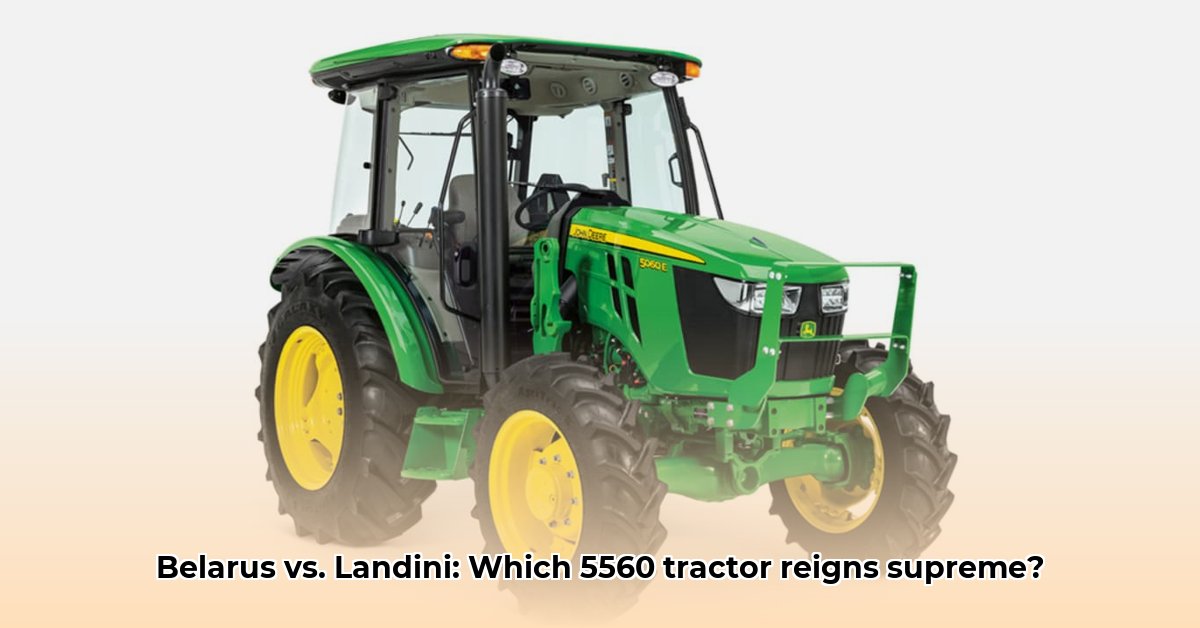
Choosing the right tractor is a critical decision for any farmer, especially those prioritizing sustainable agricultural practices. This comparative review analyzes two popular compact tractors—the Belarus 5560 and the Landini 5560F—to help you determine which best suits your needs and environmental goals. We'll explore power, maneuverability, sustainability considerations, and maintenance costs to provide a comprehensive comparison. For smaller farms, consider options like the 40 HP Kubota.
Power and Performance: A Head-to-Head Comparison
The Belarus 5560 boasts a significant power advantage with 65 PTO horsepower, compared to the Landini 5560F's 52.3 hp. This extra power translates to superior performance in heavy-duty tasks like plowing large fields or lifting substantial loads. The Belarus also offers a higher rear lift capacity (7,048 lbs vs. 5,732 lbs), making it better suited for heavy lifting jobs such as compost handling, a key aspect of sustainable farming. However, the Landini's smaller engine may result in better fuel efficiency, although concrete fuel consumption data is currently unavailable for either model. This highlights a crucial area needing further investigation for a complete analysis.
Maneuverability and Farm Suitability: Agility vs. Strength
Maneuverability is another key factor. The Landini 5560F, with its shorter wheelbase (74.7-77 inches compared to the Belarus' 96.5 inches), offers superior agility in confined spaces like orchards or vineyards. The Belarus, while offering a 4WD option for challenging terrain, is less nimble in tight situations. The choice largely depends on your farm's layout and the types of crops you cultivate. Do you need to maneuver between rows of closely spaced plants, or do you primarily work in open fields? This question will significantly influence your decision.
Sustainability Considerations: Environmental Impact
Sustainability encompasses more than just fuel consumption. While neither tractor possesses explicit sustainability certifications, we can assess their environmental impact. The Landini's smaller engine likely produces fewer emissions, contributing to a smaller carbon footprint. Conversely, the Belarus's higher lift capacity could be advantageous for managing compost and other farm waste, promoting a circular economy. However, a complete sustainability assessment requires further research, particularly concerning the embodied carbon—the carbon dioxide emissions generated during manufacturing—for both tractors.
Maintenance and Cost: The Long-Term Perspective
The provided data lacks specific details on maintenance costs, repair accessibility, and parts availability for both tractors. A complete comparison requires further research into these crucial long-term economic factors. The total cost of ownership—encompassing maintenance, repairs, and parts replacement—will significantly impact the overall sustainability and economic viability of your choice.
Key Specifications at a Glance:
| Feature | Belarus 5560 | Landini 5560F |
|---|---|---|
| PTO Horsepower | 65 hp | 52.3 hp |
| Rear Lift Capacity | 7,048 lbs | 5,732 lbs |
| Wheelbase | 96.5 inches | 74.7-77 inches |
| Drive Train Options | 4WD | 2WD & 4WD |
| Engine Size | 4.8L | 2.5L |
Conclusion: Choosing the Right Tractor for Your Farm
The Belarus 5560 and Landini 5560F each offer distinct advantages. The Belarus excels in power and heavy lifting, making it suitable for larger farms or those requiring substantial hauling capacity. The Landini's agility and potential fuel efficiency make it ideal for smaller operations, particularly those with limited space and a focus on precise maneuverability. The optimal choice depends on your specific farming needs, farm size, and commitment to sustainable practices. Thorough investigation into fuel efficiency and long-term maintenance costs is essential before making a final decision. Remember to consider the total cost of ownership to ensure a long-term sustainable investment.